The MSI X299 Gaming M7 ACK Motherboard Review: Light up the Night
by Joe Shields on March 5, 2018 10:00 AM EST- Posted in
- Motherboards
- MSI
- ATX
- M.2
- USB 3.1
- RGB
- X299
- Basin Falls
- Skylake-X
- Kaby Lake-X
- i9-7900X
MSI X299 Gaming M7 ACK Visual Inspection
Our first real glimpse of the board on the previous page shows the Gaming M7 ACK isn't a run of the mill budget board. For its price point, it certainly shouldn't be. The PCB is matte black with only a few distinguishing colors, with all heatsinks and shrouds a grey color. The back panel IO shroud extends down through the PCIe area and covers the audio bits in the process. The color is left to the RGBs: the back panel IO portion has RGB LEDs, along with five more between the PCIe slots on the bottom portion of the shroud. The power delivery heatsink sitting above the socket also includes integrated RGB LEDs.
What is easily noticable when looking at the board is the chipset heatsink, which is quite unique with its shape. The heatsink, along with cooling the chipset, doubles as an M.2 module cooler, with arms spreading out between the PCIe slots. While having M.2 cooling isn't unique by itself, the cooling is hinged with the chipset heatsink, allowing the cooler to pop up rather than be removed entirely. I have to say this is one of the more clean implementations of a robust M.2 cooler.
Diving into the specifics of the board, the MSI Gaming M7 ACK includes a total of six fan headers. On the top is where the CPU Fan 1, Pump Fan 1, and SYS Fan 1 reside, with the latter two located in the upper right-hand corner by the debug LED, and the CPU Fan on the left above the DRAM slots and to the left of the EPS power connectors. The remaining three headers, called SYS Fan 2/3/4, are located at the bottom of the board. All six headers have the ability to control the attached fans via PWM or DC. The CPU and Pump fans have an LED to indicate the fan control mode visually with red being PWM and green DC. MSI documentation does not mention if any of the headers are high amperage.
For the power delivery, MSI touts a 12-phase power delivery with 10-phases (a doubled 5-phase design) going to the CPU, and another phase for the VCCSA. Driving these are International Rectifier's IR3550 fully integrated power stages with an IR35201 multi-phase buck controller. The doubling duties are handled by five IR3599 doublers. The memory power delivery uses a Primarion PV4210 PWM with each memory phase using two 25A/40A NexFETs, in the CSD87350Q. Sending power to the VRMs is an 8-pin EPS and an (optional) 4-pin EPS connector. These premium power bits are the same that we found on the X299 Gaming Pro Carbon AC.
The board comes with eight slots for memory, which are all reinforced by MSI's Steel Armor. Keeping the memory locked in place is a single latch on the top of the DRAM slot. Compared to dual latch systems, the single latch is a bit easier when the system is installed, and still locks the sticks down securely, but might require a double check on the bottom latch to make sure the memory is in place. The board supports both Dual and Quad channel DDR4 with capacity up to 128GB. Memory speed for quad-channel processors is up to DDR4-4266, and DDR4-4500 with dual-channel processors.
The top-down image of the right side of the board shows, in the bottom corner, two of the eight SATA ports oriented vertically from the board. This follows with a U.2 connector, the six SATA ports, a front panel USB 3.1 header, and a pair of USB 3.0 headers.
To the right of the 24-pin ATX connector are EZ debug LEDs (4), for Boot, DRAM, VGA, and CPU, which give a visual display of where the board is at in POST. Located directly to the left of those are a miniature set of voltage read points covering Vcore, VCCIO, VCCSA, DDR, CPU (input voltage), and Ring voltage. These are quite helpful when extreme overclocking, rather than relying on software readouts.
Across the bottom of the motherboard, there are several IO headers and a couple of buttons. From left to right we see:
- Front Panel Audio
- RGB LED header
- Sys Fan 2/3/4 headers
- Front Panel connectors
- 2 x USB 2.0 headers
- VROC header
- Power Button
- Reset Button
- Game Boost knob, that goes up to 11
- 2 x SATA ports
Hidden under the shroud on the left, connecting to the front panel audio, are two Realtek ALC1220 audio chips. Two is not a typo. MSI has one set up for front panel audio, and the other for audio output on the rear. It also uses Chemicon Gold Series audio capacitors for the front and rear outputs as well as separated audio layers for the left and right channels.
The bottom half of the board has a total of six PCIe slots with all four full-length slots reinforced. Between the full length slots are two x4 slots connected via the chipset. The primary video card slots are all CPU connected (lane breakdowns in the table below). The primary video card slot slots are, from top to bottom, slots one and four. This configuration allows for double and triple wide cards to fit. Any three-way SLI/Crossfire action will utilize slot 6 (bottom slot).
Below is a simplified list of how the PCIe slots will work with each family of CPUs (talking PCIe lanes) when multiple cards are used (the "@" symbol is used to show slot preference for the configuration):
| MSI X299 Gaming M7 ACK CPU PCIe Layout | ||||||
| 44-Lane 1/2-Way |
44-Lane 3-Way |
28-Lane 1/2-Way |
28-Lane 3-Way |
16-Lane 1-Way |
16-Lane 2-Way |
|
| PCIe 1 | @x16 | @x16 | @x16 | @x8 | @x8 | @x8 |
| PCIe 3 | x4 | x4 | x4 | x4 | x4 | - |
| PCIe 4 | @x16 | @x16 | @x8 | @x8 | x4 | @x8 |
| PCIe 6 | x8 | @x8 | - | @x8 | - | - |
| SLI | Yes | Yes | Yes | Yes | - | Yes |
| Crossfire | Yes | Yes | Yes | Yes | - | Yes |
So what might seem odd here is that the PCIe 3 slot is listed as PCIe 3.0 x4 from the CPU in all configurations, despite being a full sized slot. This is due to the breakdown with the PCIe lanes for the U.2/M.2 slots.
The back panel IO has the following connectors:
- 1 x Clear CMOS
- 1 x BIOS Flashback+ button
- 1 x PS/2 Keyboard/mouse combo port
- 3 x USB 2.0 ports
- 2 x Wi-Fi Antenna connectors
- 4 x USB 3.1 (5 Gbps) ports
- 1 x LAN (RJ45) ports
- 1 x USB 3.1 (10 Gbps) Type-A port
- 1 x USB 3.1 (10 Gbps) Type-C port
- 1 x Optical S/PDIF OUT connector
- 5 x OFC audio jacks
In the Box
The MSI X299 Gaming M7 ACK includes the following accessories:
- Driver & Utilities Disk
- Motherboard User Guide
- 4 x SATA cables
- IO Shield
- SLI HB Bridge M
- 1 x 1 to 2 RGB LED Extension Y Cable (80cm)
- Quick Installation Guide, SATA Labels, Manual
- 3D X-Mounting Screw pillars
- Case badge
- 2 x Antenna




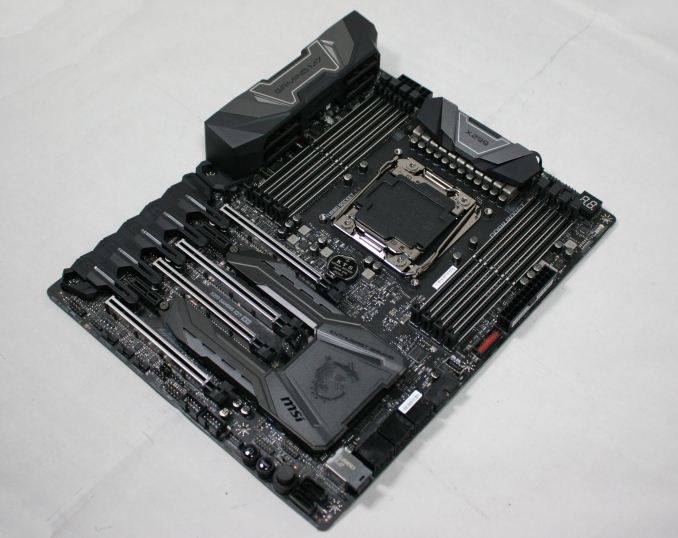

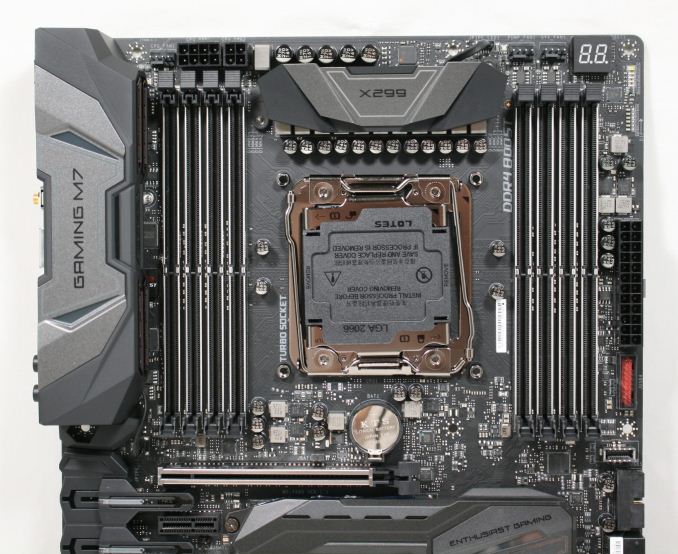
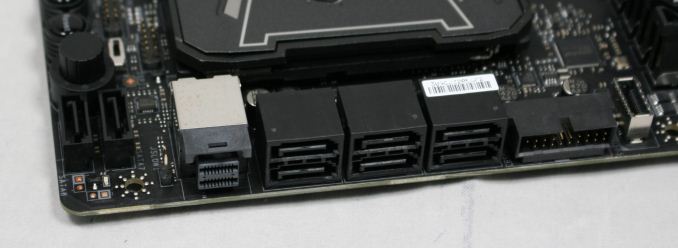


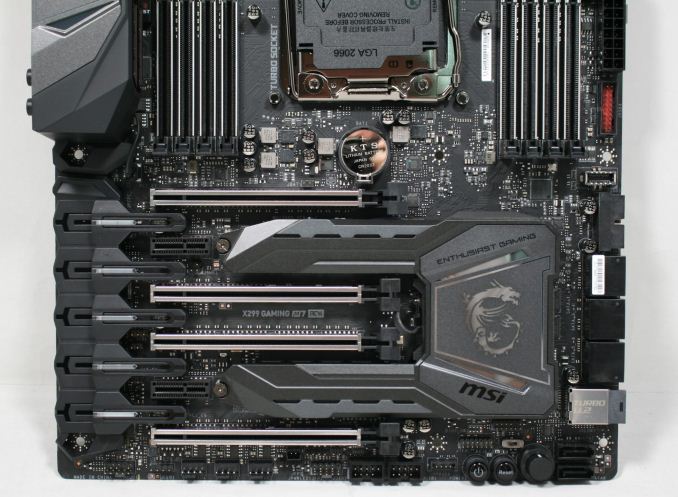
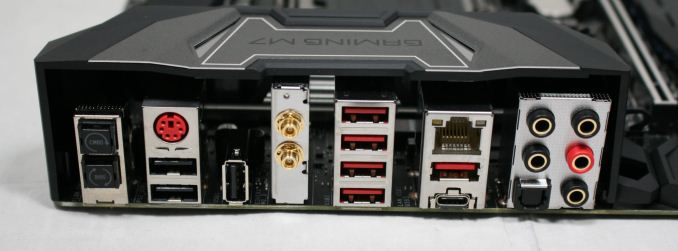
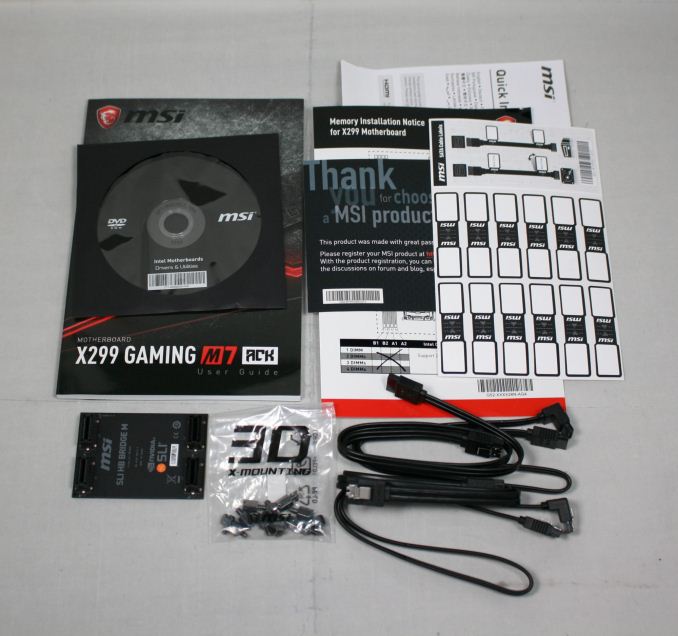














32 Comments
View All Comments
mkaibear - Monday, March 5, 2018 - link
>dual Realtek audio chipsHrm
>Killer based networking,
Pass
> and plenty of RGB LEDs to light up the case
Hard pass
CheapSushi - Monday, March 5, 2018 - link
Hating on Killer NICs has become a dumb meme. And guess what? The newer chips are often actual Intel. https://www.anandtech.com/show/12178/its-actually-...mkaibear - Monday, March 5, 2018 - link
I choose to "hate on them" because their USP is that they make the board somehow faster in online gaming, yet every independent test shows them to not do that - plus they increase the BOM significantly for no real benefit.The Killer chips on this board aren't Intel btw.
(There's a bit of personal history involved too - I've had several machines with Killer networking chips and they've all had significant driver problems)
nevcairiel - Tuesday, March 6, 2018 - link
Reputation is hard to fix, and if its just an Intel chip, whats the premium you get from those exactly?Personally I'll always prefer a board with plain Intel NICs, and WiFi on a PC board is meaningless to me anyway (the one you linked is Killer WiFi, not Ethernet)
Flunk - Tuesday, March 6, 2018 - link
Still a waste of money on that BoM and you get the annoying Killer app.Something being mentioned in a meme (and all memes are dumb), doesn't make it untrue.
Pork@III - Monday, March 5, 2018 - link
RGB LED give you +20 armor :D69369369 - Monday, March 5, 2018 - link
RGB LED give me erection :DPeachNCream - Monday, March 5, 2018 - link
Yet another x299 motherboard review of yet another yawn-fest RGB and Killer NIC been there and done that also ran gaming product. What's missing here is a non-standard approach and reviews up and down the product stacks of various vendors. This is what happens when you rely exclusively on what companies are willing to send you for free in the mail. They spoon feed journalists a series of gaming-class products with stupid features so we readers rarely see any decent analysis on the wider cost ranges of boards out there because poor people like Joe end up wasting their time messing with boards that only a small number of people purchase. The same thing happens with phones, processors, GPUs, and so forth.I'm sorry if this sounds rude, but it's frustrating and makes this Peach not overly fond of tech journalism at large. Add that to the years of touting Rivet Networks Killer products without ever justifying it with a benchmark or two that demonstrates there's a reason for the boosting writers have to do and it the whole site feels disappointing even if there's value in other articles. I mean there's not even a networking benchmark at all so we can't even infer added value by comparing a Killer whatever to vanilla Intel using results elsewhere. If the opening shots of the article are going to cite networking connectivity, why isn't that given even a cursory examination in the subsequent pages? What's going on Anandtech?
Ian Cutress - Monday, March 5, 2018 - link
Networking is extremely hard to get right as a test. It's easy to run it at peak speeds, but networks are rarely used in that instance.As for the marked benefit of Killer, it comes down to something not overly benchmarkable: online performance with concurrent data streams. If you are gaming, plus downloading, plus streaming, plus watching youtube on another monitor etc, the priority thing does its job. Most solutions are purely software-based - Killer's stuff is actually in hardware: for what isn't whitelisted, the packet analytics can work to decipher what sort of data is coming through, and from where: video, audio, direct downloads, torrents, and such all have detectable ways that the packet data is processed. Different codecs can have different packet profiles, and the Killer stuff is designed to detect them and adjust the return priority as appropriate. A packet will get tagged with a priority and sit in the incoming/outgoing queues, sometimes bypassing the queue altogether. Without deep networking knowledge, and hooks into the Killer hardware requirements, this is super difficult to benchmark. Unless you want a non-repeatable test with an uninterpretable result, or a repeatable test with no real-world value.
I'd love to get some proper Killer testing in, combined with an interview with the CEO and CTO. I can just tell from the comments that it would be a piece that people come just to comment negatively, rather than read, because of the Killer experience in the past. It's a topic I've discussed with the Killer team on numerous occasions.
As for the glut of X299 reviews, we have different reviewers for each chipset/socket: Joe on X299/Z370, Gavin on AM4, Tracy on TR4. Tracy has been waylayed due to lack of hardware, Gavin is new so getting up to speed, and Joe is powering through. Joe is only just moving to Z370 as well, and has a few of those already half-done.
timecop1818 - Monday, March 5, 2018 - link
> I'd love to get some proper Killer testing in, combined with an interview with the CEO and CTO.Why not actually do that? I would come to read it and laugh at the graphs showing killer not excelling at anything in particular.
I guess the reason there's not a killer nic review out there is because it would show how embarrassingly stupid the whole thing is, providing zero advantage at additional cost and actually making things worse by shitty drivers. I don't buy that QoS bullshit, Ian, you're not stupid, if some idiot is shittorenting on ADSL no amount of qos/killer is gonna make a difference when upstream is saturated. Most "gamers" that this is targeted at will either have appropriate broadband connection or be smart enough not to use bandwidth during their gaming sessions. Also with things like NAS etc having torrent/etc clients I just don't see many people using their primary gaming rig for downloading crap (or using shittorrent at all, i know i haven't for years).
I was looking at buying new XPS13 from Dell, saw it had soldered (not socket) killer WiFi, passed it for another brand.